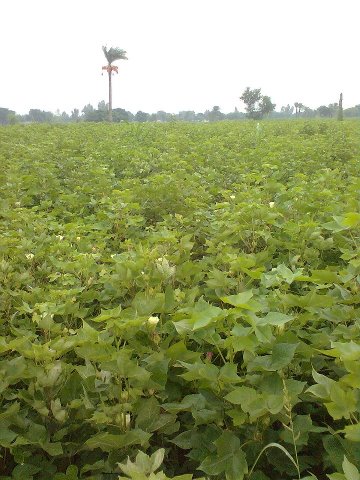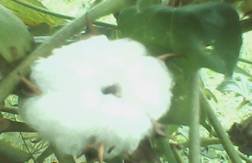|
|
Advanced Methodology For Hybrid Seed Production in Cotton
By:
Shehzad Ahmad Kang, Department of Plant Breeding and
Genetics, University of Agriculture, Faisalabad, Pakistan.
Introduction
 Pakistan is eyeing record cotton production of over 15
million bales in the 2011/12 crop year as farmers sow a
wider area after domestic prices more than doubled from a
year ago. Cotton and textile account for about two-thirds of
the country's exports and a healthy cotton crop is vital to
economic growth, which is expected to slip to around 2.75
percent in the current financial year to June, because of
flood damages. Pakistan is eyeing record cotton production of over 15
million bales in the 2011/12 crop year as farmers sow a
wider area after domestic prices more than doubled from a
year ago. Cotton and textile account for about two-thirds of
the country's exports and a healthy cotton crop is vital to
economic growth, which is expected to slip to around 2.75
percent in the current financial year to June, because of
flood damages.
The world's fourth-largest cotton producer had hoped to
produce 14 million bales in the 2010/11 crop year before the
devastated summer floods last year reduced the output to
about 11.70 million bales (Anonymous, 2011-12). There is
more need of seeds / seed cotton (kapas) due to increasing
population for the consumption of human. Breeder’s do more
research work for the development of hybrid genotypes to
enhance the cotton seed yield/ lint yield.
-
Cultivated species of Cotton are two types viz.
Tetraploids of Cotton
-
Gossypium hirsutum (2n = 52)
-
Gossypium barbadense (2n = 52)
Diploids of Cotton
-
Gossypium arboreum (2n = 26)
-
Gossypium herbaceum (2n = 26)
Hybrids & Species
-
Hybrids between the cultivated species of same ploidy
level are fertile.
-
Four intra specific hybrids (one in each species) and
two inter specific hybrids of same diploid no. between
Gossypium hirsutum x Gossypium barbadense and Gossypium
arboreum x Gossypium herbaceum.
-
Totally 6 different types of hybrids are theoretically
possible.
Species from which hybrid
developed
-
Four types of hybrids are only developed for commercial
cultivation,
-
Intra specific hybrids in Gossypium hirsutum and
Gossypium arboreum.
-
Inter specific hybrids between tetraploids viz.,
Gossypium barbadense and Gossypium hirsutum and diploids
G. arboreum x G. herbaceum.
-
Inter specific hybrids between G. barbadense and G.
herbaceum could not be released.
Hybrid seed production
-
In cotton, there are two methods of hybrid seed
production, viz.,
-
Conventional method, and
-
Male sterility based method.
These are briefly discussed below
Conventional Method
-
Breeder or certified seed of male and female parents is
used for the production of hybrid seed.
-
Hybrid seed production is carried out by hand
emasculation and pollination.
-
This method ensures purity in seed production.
-
The female and male parents are planted in the same
field in separate plots in 4:1 or 3:1 ratio.
-
Sowing of parental material is done in such a way that
there should be nicking in the flowering time of both
the parents.
-
The off type plants are rogued out before initiation of
crossing programme.
-
The female and male parents are planted at wider spacing
for easy movement during crossing.
-
Higher doses of fertilizer and recommended plant
protection measures are used to raise healthy crop to
get continuous flush of flowers.
-
Crossing work is started after one week of flower
initiation.
-
Flower buds which are likely to open the next day are
chosen for emasculation.
-
Anthers of selected buds are removed gently with the
help of nail (emasculation) as suggested by Doak method.
-
Emasculated buds are covered with tissue paper bag of
red color to prevent natural out crossing.
-
The best time for emasculation is 3:00 – 6:00 PM.
-
Emasculated buds are pollinated the next day with the
pollen of male parent.
-
The best time for pollination is 8:00 – 11:00 AM,
because stigma receptivity is maximum during this
period.
-
4-5 buds are pollinated by one flower of male parent.
-
After pollination, the red tissue paper bags are
replaced by white tissue paper bags for identification.
-
A label or thread is also tied on the pedicel for
identification.
-
Fertilization occurs after 12-30 hours of pollination.
-
Cross buds should remain covered for 3-4 days after
pollination.
-
The straw tube used for cool drink is also used for
covering the stigma of emasculated buds before and after
pollination.
Male sterility method
-
This method is used for hybrid seed production of only
those hybrids which have been developed through the use
of male sterility. Use of male sterility reduces only
the cost of emasculation. Pollination has to be done
manually.
-
Two types of male sterility systems are used in cotton,
viz.,
-
Genetic male sterility, and
-
Cytoplasmic genetic male sterility.
Use of Genetic Male Sterility
-
In cotton, Gregg male sterility source is used.
-
The male sterility is transferred to the female parent
through backcross technique.
-
The male sterility is governed by two recessive genes
(ms5 ms6).
-
A heterozygous male fertile genotype which segregates
only is identified.
-
Cross of this male fertile genotype with sterile line
will always produce male sterile and male fertile plants
in 1:1 ratio.
-
Fertile plants are identified after flowering are
removed.
-
The male sterile plants are pollinated with the pollen
of male parent to get hybrid seed.
-
In case of male sterile parent, 3-4 seeds should be sown
per hill because 50% of the population (male fertile) is
removed when flowering starts.
Use of Cytoplasmic Genetic Male Sterility
-
In cotton, G. harknessii cytoplasm is used as a source
of cytoplasmic genetic male sterility.
-
The male sterility is transferred to the female parent
and restorer gene to the male parent by backcross
technique.
-
The male sterile and restorer lines are planted in the
same field but in separate plots in 4:1 or 3:1 ratio.
-
The crop is grown at wider spacing under irrigated
conditions to get continuous flush of flowers for seed
production.
-
Crossing is started after one week of flower initiation.
-
The male sterile parent (female) is pollinated with the
pollen of restorer (male) parent.
-
After pollination, flowers are covered with tissue paper
bags to avoid natural out crossing with other plants.
Materials required
-
Tissue paper bags (10 x 15 cm) red and white colored or
straw tubes. Magnifying glass,
-
Tray,
-
Thread,
-
Note book and pencil etc.,
Crossing techniques
-
In cotton, hybrid seed production is carried out by
artificial crossing. The crossing refers to hand
pollination. The crossing technique consists of three
main steps, viz.,
-
selection of bud,
-
emasculation, and
-
Pollination.
 Selection of Bud Selection of Bud
-
The selection of flower bud for emasculation is an
important step in hybrid seed production. The crossing
work is initiated after one week of flower initiation.
The flower buds of proper stage (buds which are likely
to open the next day) are selected for emasculation.
Such buds have generally cream color and are well
developed.
Emasculation
-
The process of removal of anthers from the selected
flower bud is referred to as emasculation.
-
Anthers of selected buds are gently removed with the
help of nail of the thumb as suggested by Doak (1934).
The emasculated buds are covered with tissue paper bag
of red color to prevent natural out-crossing. The best
time for emasculation is 3-6 PM. Some people use straw
tube to cover the ovary of emasculated bud. Emasculation
is not required when hybrid seed is produced using male
sterility.
Pollination
-
Emasculated buds are pollinated the next morning with
the pollen of male parent. The best time for pollination
is 8:00 – 11:00 AM, because the stigma receptivity is
maximum during this period. Generally, 4-5 buds are
pollinated by one flower of male parent. After
pollination, the red tissue paper bags are replaced by
white tissue paper bags. For identification, a label or
thread is also tied on the pedicel of crossed bud for
identification of crossed bolls.
Picking
-
Pick completely opened crossed boll (kapas) as and when
ready in baskets and sort out.
-
Any bolls without thread be kept aside and only genuine
crossed bolls are kept separately for use.
-
Remove hard locks, stained kapas (seed cotton) etc. keep
good crossed boll kapas for processing.
-
Dry well-cleaned kapas in shade after each picking and
store in a good place picking-wise lots.
Ginning
-
Slow ginning is to be practiced to recover good quality
seed and without cutting the seed. After ginning, the
seeds may be kept well spread, air dried, without
heaping.
Standards for Certified Hybrid Seed
-
There are four basic requirements for production of
certified hybrid seed. These are:
-
Notified hybrid,
-
Genetic purity,
-
Physical purity,
-
Proper germination. A hybrid released either by State
Variety Release Committee or Central Variety Release
Committee is selected for production of certified hybrid
seed.
-
It is also essential that the hybrid should be notified
one.
-
Genetic purity refers to absence of seeds of other
variety. Genetic purity is determined by grow out test.
Advantages and Disadvantages
Advantages
-
Superior yield performance coupled with superior fiber
properties.
-
Wider adaptability
-
Good price for the produce
-
Employment generation through labor intensive hybrid
seed production.
-
Short duration hybrids can fit into multiple cropping
system under irrigated areas.
-
By inclusion of cotton in double and multiple cropping,
cotton will find place in crop rotation in new areas,
thus contributing to increased area under irrigated
cotton without impairing the area of other crops.
Disadvantages
-
high cost of seed,
-
high cost of cultivation,
-
difficulty in seed production and
-
Neps and motes especially in interspecific hybrids.
High Cost of Seed
-
In cotton, the hybrid seed is usually produced by hand
emasculation and pollination which is very costly.
-
This high cost of seed can not be offered by small and
marginal farmers.
-
Even if the male sterile line is used, the pollination
has to be done by hand. (Extent of natural out-crossing
in Pakistan is about 6%)
High Cost of Cultivation
-
The cultivation of hybrids is input intensive. Hybrids
require more inputs in terms of fertilizers and
pesticides than varieties. The high cost of cultivation
can not be offered by small and marginal farmers. The
high cost of seed and cultivation act as barriers in the
expansion of area under hybrid cotton. Hence, there is
need to develop cotton hybrids of low input technology.
Difficulty in Seed Production
-
The diploid hybrids could not become popular among the
farmers due to difficulty in seed production. The seed
setting in diploid crosses is very low (about 25%) which
posses problems in hybrid seed production.
Upland cotton hybrids in
Pakistan
.
Corresponding author’s email:
shehzadpbg@gmail.com
Courtesy: PAKISSAN Team |
|
Pakissan.com;
|